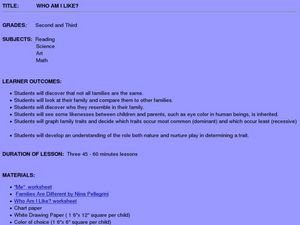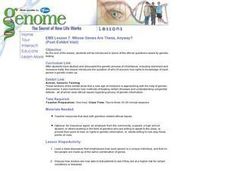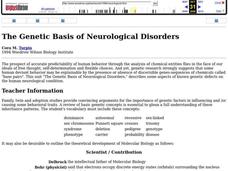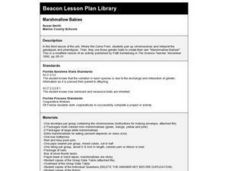Curated OER
Genetics Crossword
In this biology worksheet, students complete a crossword puzzle with 38 questions on genetics. They identify the different parts and functions of a flower.
Curated OER
Natural Selection And Evolution
Seventh graders investigate the concept of natural selection and its relationship to the theory of evolution. They conduct research using a variety of resources and use the information to create a class presentation and open up the...
Curated OER
What Should I know for the Test?
A three-page quiz about genetics, which includes Punnett squares, blood types, questions about Mendel and his contributions, and vocabulary comprehension. Use this for a study guide, a pretest/post-test, or a note-taking worksheet in...
Curated OER
Chapter Fourteen Questions: Human Genome
This multiple-choice and short-answer quiz covers chromosomes, genetic disorders, and more. The multiple choice section could work as a pretest, as well.
Curated OER
Where Are the Dinosaurs?
Young scholars explore the concept of extinction by studying dinosaurs. In this dinosaur lesson, students distinguish between extinct creatures and those that still exist.
Curated OER
ABO Blood Types Worksheet
Blood types and transfusions are explained in reading passages at the top of the worksheet. A chart of blood type compatibility is also provided. Biology students answer comprehension questions and then exercise critical-thinking skills...
Curated OER
Brays Bayou Spiderwort Genetic Study
Young scholars formulate hypothesis based upon data gathered by examining possible crosses of spiderworts using Punnett squares. They present explanations for physiological adaptations of spiderworts that resulted from interactions...
Curated OER
Pea Plants Dihybrid Cross
In this dihybrid cross activity, students are given four crosses to complete using punnett squares. They determine the genotypic and phenotypic ratios of the offspring.
Curated OER
Heredity
For this science worksheet, students find the answers to various types of heredity problems. They use the sheet to set goals for completing the unit.
Curated OER
Who Am I Like?
Students examine family structures. In this family structure lesson, students discover things about their own families and those of their classmates. They make a chart as they discuss nature versus nurture, complete a worksheet about who...
Curated OER
Whose Genes Are These, Anyway?
Students explore some of the ethical questions raised by genetic testing. They answer the question of whom, if anyone, has rights to knowledge of each person's genetic make-up.
Curated OER
Genes
Students explore the history, inheritance and mutations of genetics. For this genetic lesson students complete experiments on DNA sequences.
Curated OER
Toothpick Fish
Students experiment with genes and environment for a population of "Toothpick Fish."
Curated OER
Genes Count
High schoolers view a video that reviews Mendelian genetics. They discuss the Hardy-Weinberg Law and use Popsicle sticks to simulate genetic variations and ratios in offspring.
Curated OER
Genetic Technology
In this genetic worksheet, high schoolers will complete 4 fill in the blank questions about selective breeding and determining genotypes. Then students will use a Punnett square to determine the genotype for two different breeding...
Curated OER
Frankenfish
Students learn the difference between a genotype and a phenotype. They demonstrate that recombination of gametes (coins) will result in the formation of unique individuals.
Curated OER
The Genetic Basis of Neurological Disorders
Students explore neurological disorders. They examine the presence and absence of discernible genes. Students describe neruological diseases and draw faces of affected persons. They play a human neurology disorders learning game.
Curated OER
Blue Genes: Affect Your Life!
Students, in groups, research, analyze and synthesize information on genetic diseases. After watching a video on genetics, groups perform research on a variety of genetic diseases and present their findings to the class.
Curated OER
Marshmallow Babies
Eighth graders interpret the genotypes and phenotypes, then pair up chromosomes.
Curated OER
Hardy-Weinberg Made Easy: A Seventh Way
The purpose of this lesson is to slowly introduce the Hardy-Weinberg Law and population genetics to your students after you have completed Mendelian genetics. Using this format, you ease the students into the concept by relying on the...
Curated OER
Sex-Linked Genes and Disorders
In this genes instructional activity, students determine how the gender of a baby is produced plus explore sex-linked disorders such as hemophilia. This instructional activity has 20 fill in the blank and 8 short answer questions.
Curated OER
Inheritance Word Search Puzzle
In this literacy worksheet, students find the words that are related to the concept that is the theme of the word search puzzle.
Curated OER
Drosophila Melanogaster
Students cross wild type flies and mutants, both purchased from a biological supply house (Carolina Biological Supply or Wards, for example) in groups from instructional activity one.
Curated OER
The Genetic Basis of Neurological Disorders
Students describe some aspects of known genetic defects on the human neurological condition. They participate in a variety of exercises including drawings, games, and analogies.
Other popular searches
- Dominant and Recessive Traits
- Dominant Recessive Allele
- Dominant Recessive Traits
- Dominant vs Recessive Traits

























